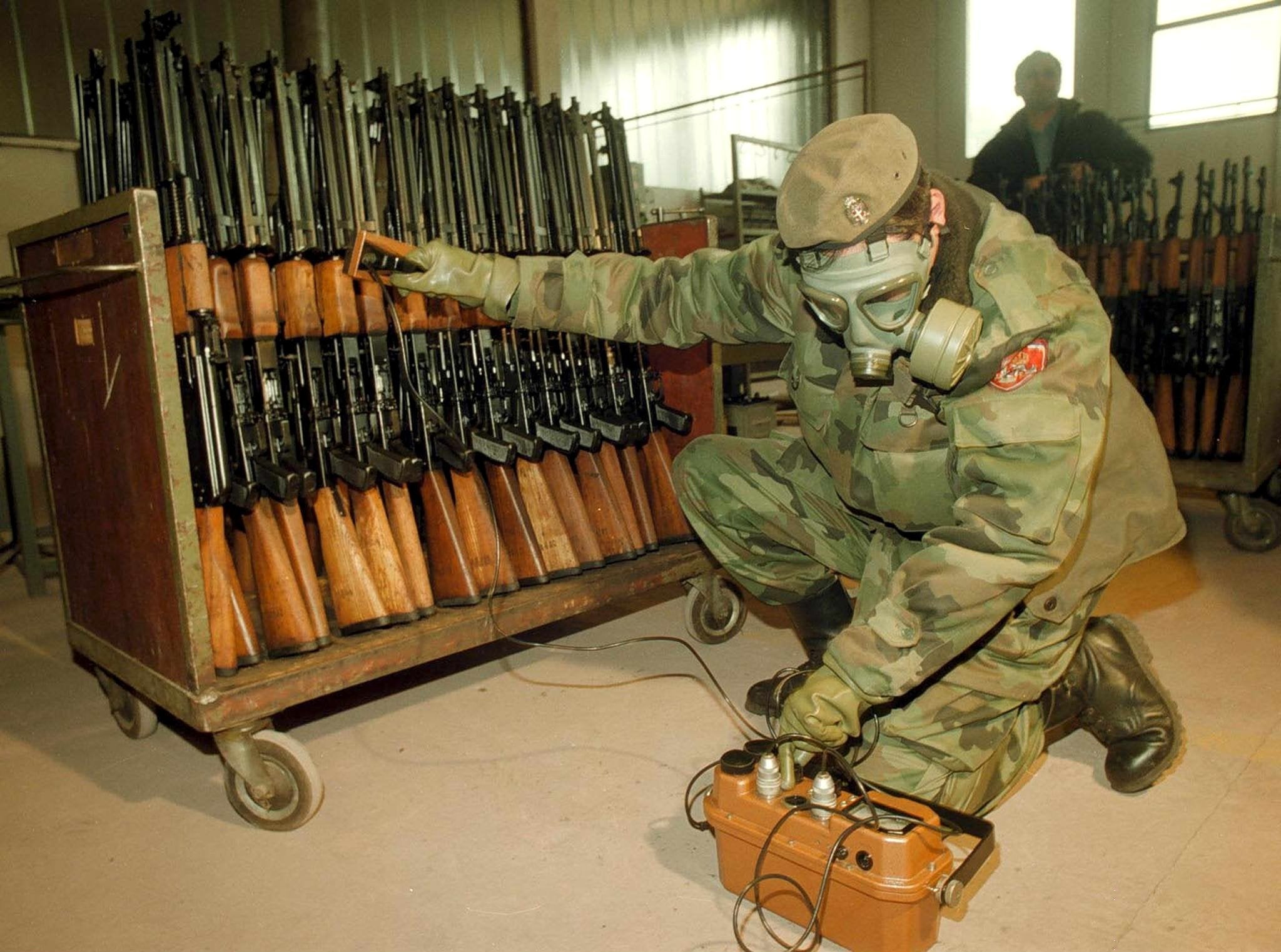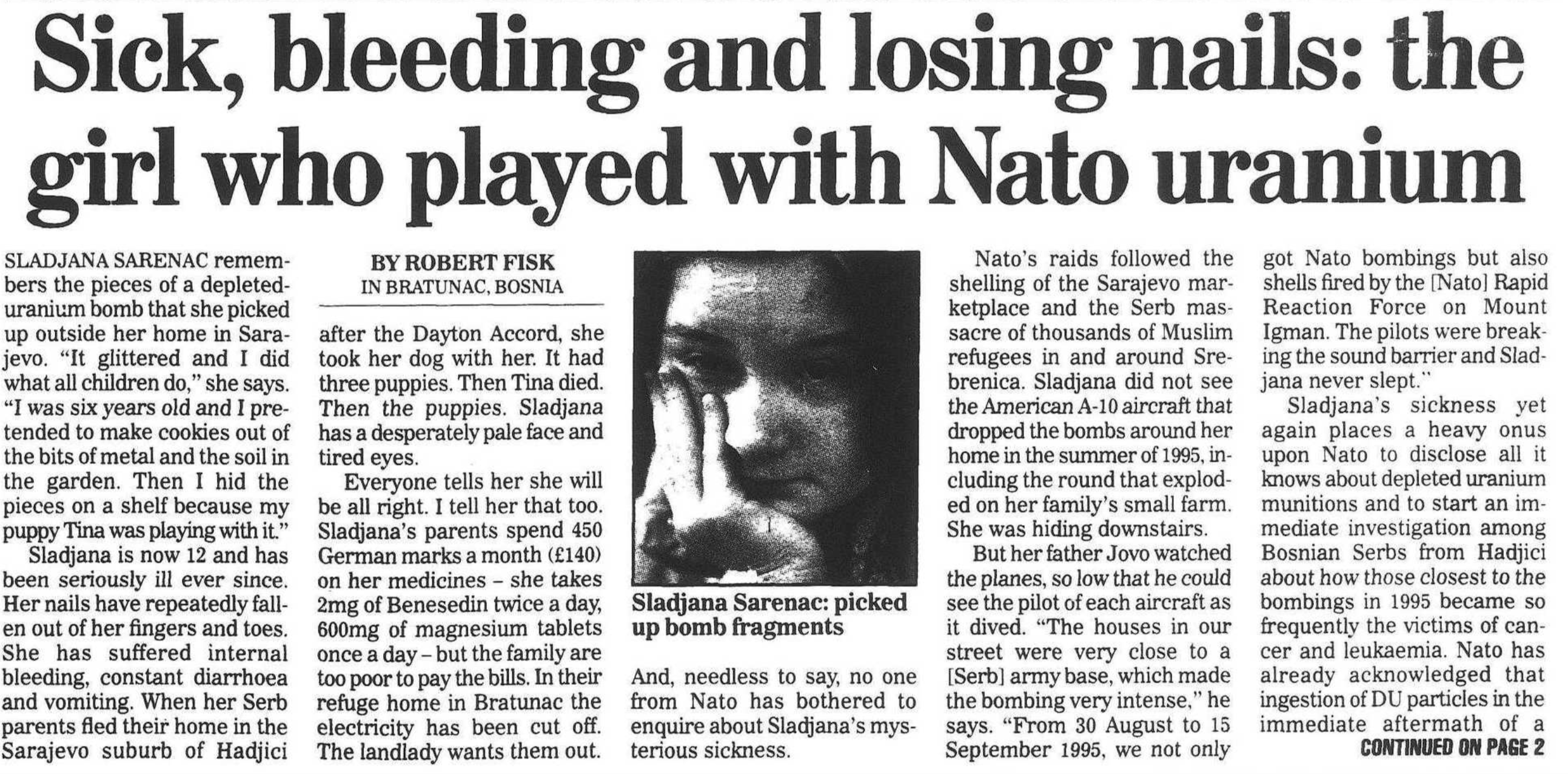Sick, bleeding and losing nails: The hidden cost of war in Bratunac
14 January 2001: Robert Fisk meets the children who played with Nato’s uranium


Sladjana Sarenac remembers the pieces of a depleted-uranium (DU) bomb that she picked up outside her home in Sarajevo. “It glittered and I did what all children do,” she says. “I was six years old and I pretended to make cookies out of the bits of metal and the soil in the garden. Then I hid the pieces on a shelf because my puppy, Tina, was playing with it.”
Sladjana is now 12 and has been seriously ill ever since. Her nails have repeatedly fallen out of her fingers and toes. She has suffered internal bleeding, constant diarrhoea and vomiting. When her Serbian parents fled their home in the Sarajevo suburb of Hadjici after the Dayton Accord, she took her dog with her. It had three puppies. Then Tina died. Then the puppies. Sladjana has a desperately pale face and tired eyes.
Everyone tells her she will be all right. I tell her that, too. Sladjana’s parents spend 450 German marks a month (£140) for her medicines – she takes 2mg of Benesedin twice a day, and 600mg of magnesium once a day – but the family are too poor to pay the bills. In their refuge home in Bratunac, the electricity has been cut off. The landlady wants them out. And, needless to say, no one from Nato has bothered to enquire about Sladjana’s mysterious sickness.
Nato’s raids followed the shelling of the Sarajevo marketplace and the Serbian massacre of thousands of Muslim refugees in and around Srebrenica. Sladjana did not see the American A-10 aircraft that dropped the bombs around her home in the summer of 1995, including the round that exploded on her family’s small farm. She was hiding downstairs. But her father, Jovo, watched the planes, so low that he could see the pilot of each aircraft as they dived. “The houses in our street were very close to a (Serbian) army base, which made the bombing very intense,” he says. “From 30 August to 15 September 1995, we not only got Nato bombings, but also shells fired by the [Nato] Rapid Reaction Force on Mount Igman. The pilots were breaking the sound barrier and Sladjana never slept.”
Sladjana’s sickness yet again places a heavy onus upon Nato to disclose all it knows about depleted-uranium munitions, and to start an immediate investigation among Bosnian Serbs from Hadjici about how those closest to the bombings in 1995 so frequently became victims of cancer and leukaemia. Nato has already acknowledged that ingestion of DU particles in the immediate aftermath of a bomb explosion can have a serious effect on health. Here are civilians who clearly were only metres away from DU explosions, who are suffering a devastating incidence of cancer, and who would willingly speak to Nato investigators, but Nato has not made the slightest effort to talk to them.

Jovo and his wife, Sretanka – and Sladjana herself – believe that her fascination with the bomb parts was her undoing. “She was playing with them like all children do,” Sretanka says. “Out of curiosity, we all went to see what it looked like after the bombings. We went into the fields where the craters were. Then, in the middle of October, Sladjana had this kind of yellow sand under the nails on her hands and toes. Then the skin round the nails became red and it hurt her a lot. She was upset, crying a lot, vomiting and suffering diarrhoea.”
That’s when Sladjana began her calvary of hospital visits: a clinic in Sarajevo, a clinic in Bratunac, medical examinations in Belgrade. Sretanka produces a wad of fading, thin carbon copies of typed hospital reports. In a hospital at Blazuj, she was given two days of blood transfusions. Doctors told her she had somehow been irradiated. Her fingernails and toenails fell out. She spent 30 hours in a coma. “In the early stages, we didn’t think it was anything to do with the bombing,” her father says. “Now we are aware of the kind of bombs that were fired, and of what happened to other people from Hadjici.” Up to 300 men, women and children who lived close to the site of the bombings in 1995 have died of cancers and leukaemia over the past five years.
It does occur to me – though I do not say so – that there are doctors aplenty in S-For, the Nato force now controlling Bosnia. And that those doctors must know all about depleted-uranium munitions and their risks. I have a feeling they will not be visiting the dark house in Bratunac where Sladjana lives.

Join our commenting forum
Join thought-provoking conversations, follow other Independent readers and see their replies
Comments